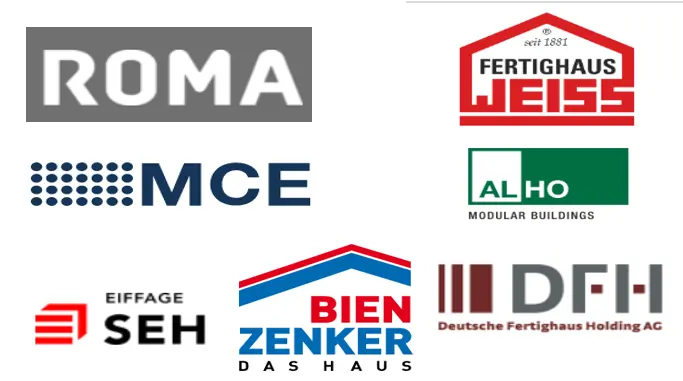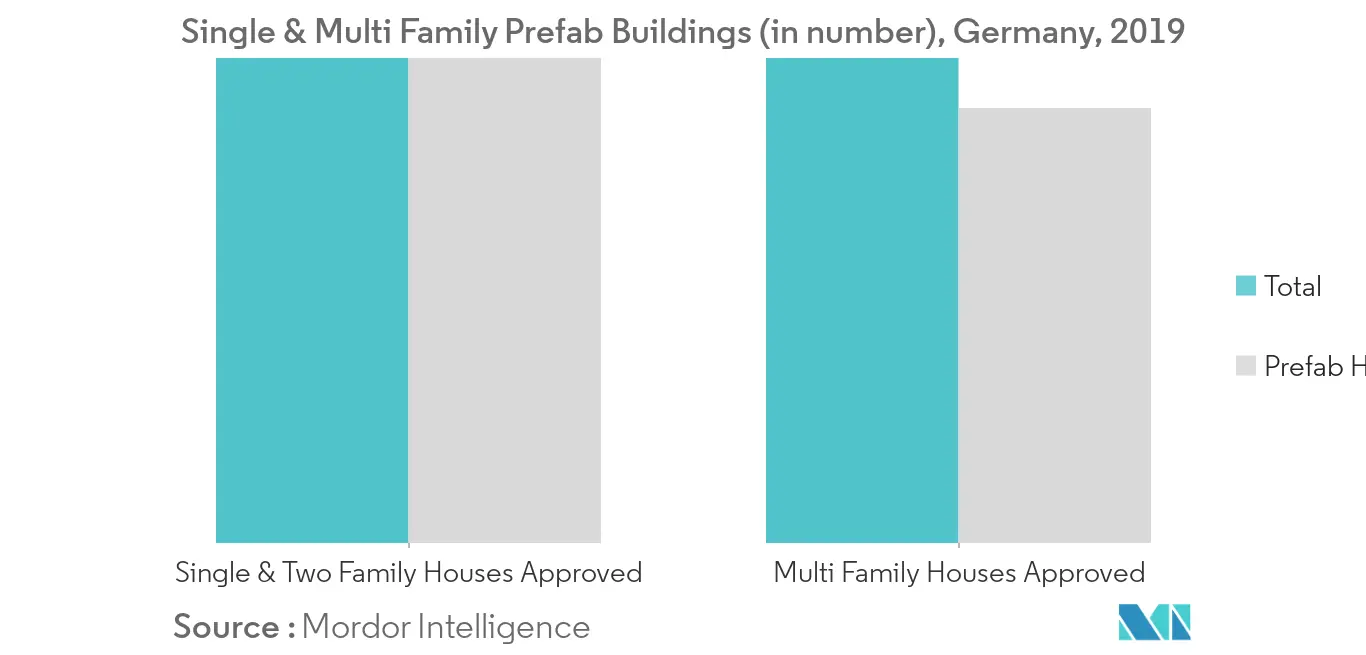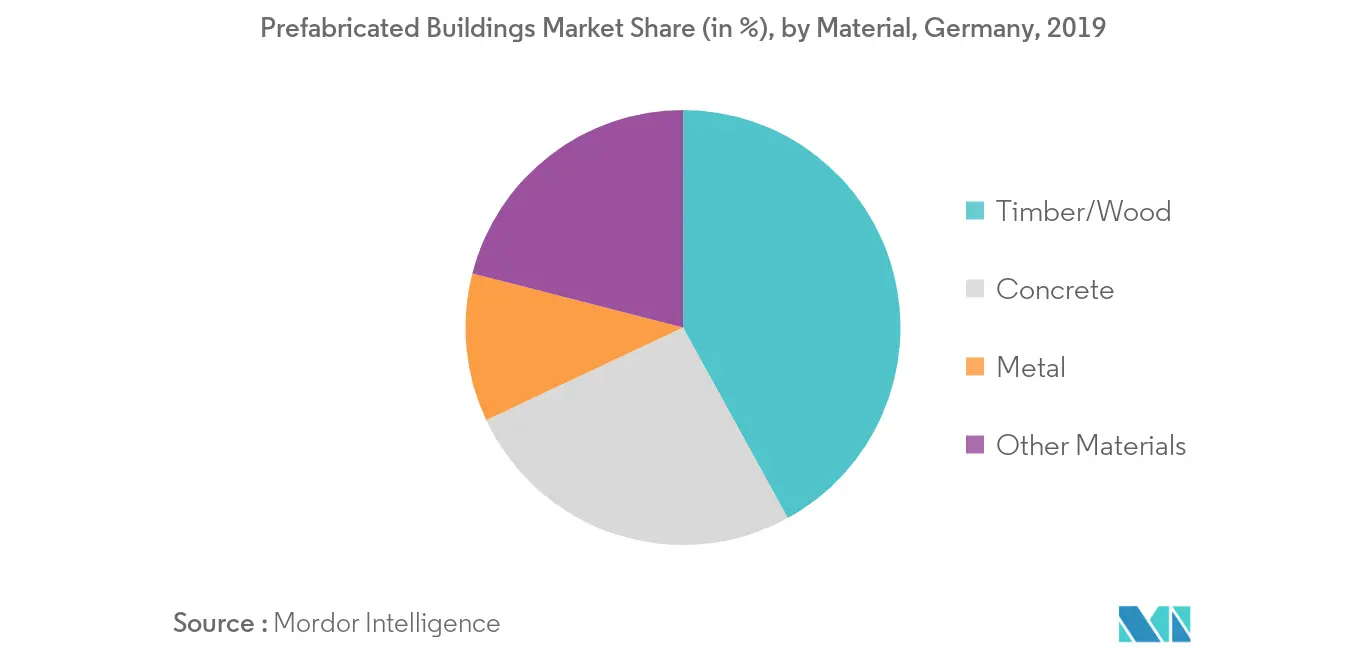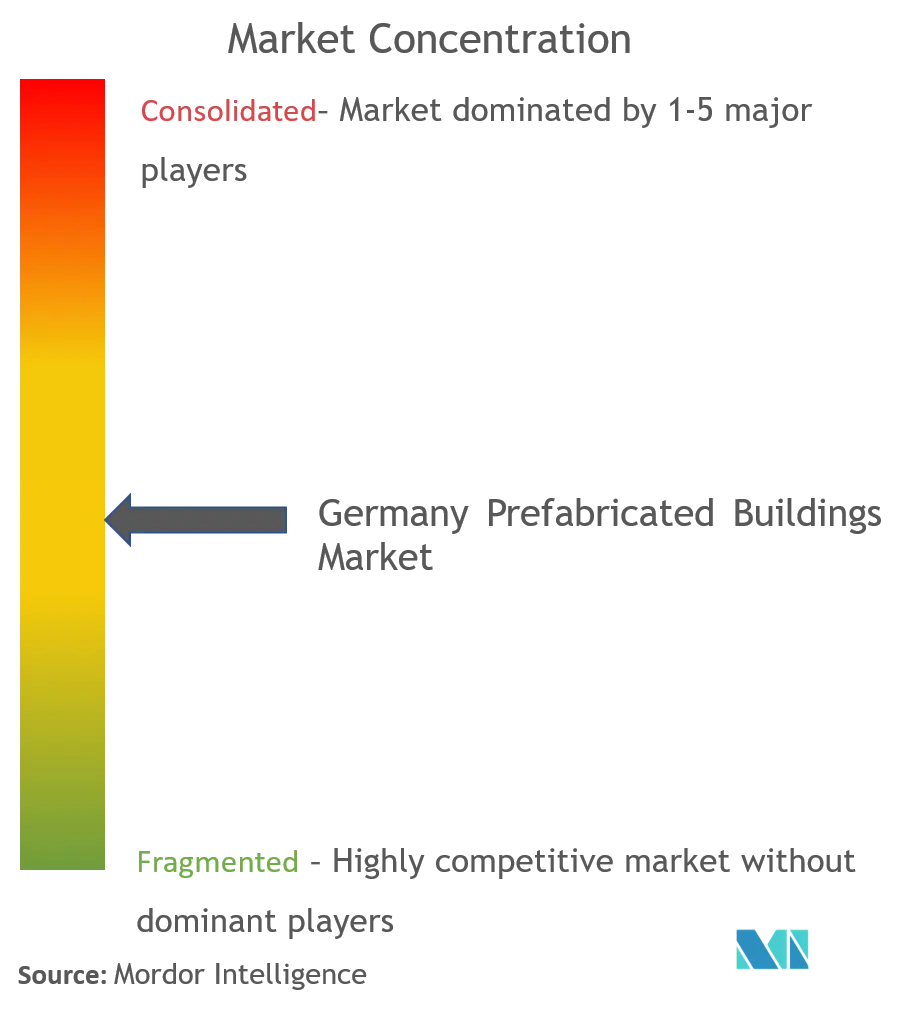
| Study Period | 2020 - 2030 |
| Base Year For Estimation | 2024 |
| Forecast Data Period | 2025 - 2030 |
| Market Size (2025) | USD 13.90 Billion |
| Market Size (2030) | USD 17.59 Billion |
| CAGR (2025 - 2030) | 4.82 % |
| Market Concentration | High |
Major Players
*Disclaimer: Major Players sorted in no particular order |
Germany Prefabricated Buildings Market Analysis
The Germany Prefabricated Buildings Industry is expected to grow from USD 13.90 billion in 2025 to USD 17.59 billion by 2030, at a CAGR of 4.82% during the forecast period (2025-2030).
The rise in the overall construction industry and as well as increasing prices are contributing to the increase in turnover of the prefab industry in Germany.
The revenue generated by the prefabricated buildings industry has seen a constant spur during the review period. In 2016, the revenue generated has amounted to USD 11.3 billion whereas, in 2019, the revenue generated was USD 12.5 billion.
In the Hesse region of the country, a total of 6796 buildings were completed in 2018, out of which 1640 included prefabricated homes. Nationwide, 5,564 prefabricated houses were approved in the first quarter of 2020, 12.8% more than in the same period last year. The overall market grew by just 2.1 percent to 24,108 newly approved one and two-family houses. As a result, the prefabricated house industry expanded its market share to 23.1 percent in the first three months of the year.
The prefabricated building industry in Germany is booming, with high growth in the residential sector. Along with the general boom in residential construction in the country, the share of prefabricated housing solutions in residential construction is increasing, which stands at more than 20%. Additionally, the high demand for turnkey or prefabricated houses as well as energy-efficient buildings is contributing to rise in prices as well as to the growth of the market.
In the German prefab housing market, single-family homes account for high share while the two-family homes and multi-storey residential units are also witnessing significant growth. In Germany, there is a higher acceptance of homes assembled in a factory, and therefore, the share of prefab homes in Germany is higher when compared to other countries such as US.
In the next few years, the growth of the prefab housing market in the country is expected to outpace the growth of the overall housing market.
Germany Prefabricated Buildings Market Trends
Comparative Study of Multi- Family Housing & Single- Two Family Housing in Prefab Industry
Modular and prefabricated technology is utilized to pursue practicality in work, as well as the speed of project development. The prefabricated building expanded its market share of the approved one and two-family houses to 20.8 percent in 2019. For the first time, the prefabricated construction exceeded the 20 percent mark - and even significantly. In 2018, the prefabrication rate was 19.6 percent and at the turn of the millennium was still a relatively 13.5 percent.
According to official statistics, in 2019 more people decided to build a one- or two-family house. However, while the overall market only grew by 1.3 percent compared to 2018, prefabricated construction developed significantly more positively than the average of all construction methods, with an increase of 7.7 percent.
From January to December 2019, a total of 101,569 new one- and two-family houses were approved, including 21,171 prefabricated houses. In ten out of twelve months, the prefabrication rate across Germany was over 20 percent. At the end of the year in December even 22.5 percent.
The prefabricated construction also has good growth rates in multi-family house construction. A total of 17,689 multi-family houses were approved in Germany in 2019, including 743 prefabricated buildings. The total number of approved apartment buildings rose by 1.6 percent compared to the previous year. The number of approved apartment buildings in prefabricated construction increased significantly more significantly by 21.2 percent.

Timber/ Wood Holds Largest Share in the Prefab Buildings Market
Timber holds the largest share in the market driven by the increase in the off-site construction activity. Timber is a widely used material in the German prefab market and Turnkey models are expected to witness high growth over the forecast period in the German prefab housing market.
The floor-covering models are also expected to witness significant growth. It is also expected to exhibit growth with a rise in non-residential and residential construction due to rising urbanization. Timber is a more widely accepted method of construction in Southern Germany and the uptake in the Northern region has traditionally been weaker. However, the demand for energy-optimized sustainable buildings has led to an increase in demand for timber constructions.
With the increasing demand for timber construction, the prefabricated timber component manufacturers are gaining confidence and are employing automated solutions. In Germany, about 25% of residential homes and apartment buildings are now being built out of wood owing to many benefits such as sustainability, fewer carbon emissions, etc.
With affordable urban housing becoming a major concern in Germany, where around 85% of the population is estimated to be urban by 2050, the need for better infrastructure with sustainability has gained prominence.

Germany Prefabricated Buildings Industry Overview
The report covers the major players operating in the Germany Prefabricated Buildings Industry. The market is highly competitive with a few players occupying the major share. The prefab housing market in Germany is fairly fragmented with the top 10 companies accounting for a market share of more than 35%. Deutsche Fertighaus Holding is a leading player in the market, with its brands 'Mass', 'Okal' and 'Allkauf. The market is expected to grow during the forecast period due to the increase in the prefab construction building investments and up-coming major projects in the country and other few factors are driving the market. Prefabricated building systems and construction hold high potential to improve the efficiency and performance of the Germany construction industry in a more sustainable sense.
Germany Prefabricated Buildings Market Leaders
-
ALHO Systembau GmbH
-
Romakowski GmbH & Co. KG
-
MCE GmbH Niederlassung Rhein-Main
-
Deutsche Fertighaus Holding
-
Fertighaus Weiss GmbH
- *Disclaimer: Major Players sorted in no particular order

Germany Prefabricated Buildings Market News
- :
- :
Germany Prefabricated Buildings Industry Segmentation
The Germany Prefabricated Buildings Market covers the growing trends and projects in prefab building markets, like commercial construction, residential construction, industrial construction. The report also covers the industry along the type of material used, like concrete, timber, glass, metal, and other types. Along with the scope of the report also it analyses the key players and the competitive landscape in the Germany Prefabricated Buildings Market. The impact of COVID'19 has also been incorporated and considered during the study.
| Material Type | Concrete |
| Glass | |
| Metal | |
| Timber | |
| Other Material Types | |
| Application | Residential |
| Commercial | |
| Other Applications ( Industrial, Institutional, and Infrastructure) |
Germany Prefabricated Buildings Industry Market Research Faqs
How big is the Germany Prefabricated Buildings Market?
The Germany Prefabricated Buildings Market size is expected to reach USD 13.90 billion in 2025 and grow at a CAGR of 4.82% to reach USD 17.59 billion by 2030.
What is the current Germany Prefabricated Buildings Market size?
In 2025, the Germany Prefabricated Buildings Market size is expected to reach USD 13.90 billion.
Who are the key players in Germany Prefabricated Buildings Market?
ALHO Systembau GmbH, Romakowski GmbH & Co. KG, MCE GmbH Niederlassung Rhein-Main, Deutsche Fertighaus Holding and Fertighaus Weiss GmbH are the major companies operating in the Germany Prefabricated Buildings Market.
What years does this Germany Prefabricated Buildings Market cover, and what was the market size in 2024?
In 2024, the Germany Prefabricated Buildings Market size was estimated at USD 13.23 billion. The report covers the Germany Prefabricated Buildings Market historical market size for years: 2020, 2021, 2022, 2023 and 2024. The report also forecasts the Germany Prefabricated Buildings Market size for years: 2025, 2026, 2027, 2028, 2029 and 2030.
Our Best Selling Reports
Germany Prefabricated Buildings Industry Industry Report
The Germany Prefabricated Houses Market is experiencing significant growth, driven by advancements in material types such as concrete, glass, metal, and timber. This market analysis reveals a robust market size and market share, with industry leaders contributing to market growth. The market report provides an in-depth industry analysis, highlighting key market trends and market research insights.
The industry report includes a comprehensive market forecast, projecting the future market outlook and industry overview. The report example and report PDF offer valuable industry information, detailing industry statistics and industry trends that shape the market landscape.
Market data and market predictions are crucial for understanding the market segmentation and market value. The market review emphasizes the importance of industry sales and industry size, while the industry research provides a detailed industry outlook.
Research companies play a pivotal role in compiling market information, ensuring that the industry reports are accurate and up-to-date. The growth rate of the prefabricated houses market is a testament to the evolving industry trends and market dynamics.
In summary, this market report delivers a thorough market overview, supported by industry research and market forecast, making it an essential resource for stakeholders looking to navigate the Germany Prefabricated Houses Market.




